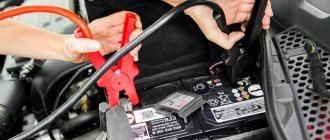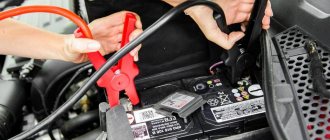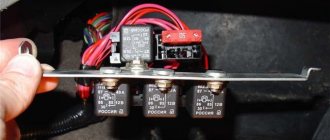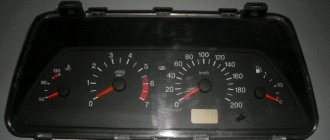With a new battery, problems rarely occur, especially if it is maintenance-free. Therefore, the need to remove it rarely arises. Still, even such batteries require periodic charging, and this operation requires care when connecting the charger. If there are usually no problems with installing a battery on a car, then when charging the probability of mixing up the wires is not so small. How dangerous is such a mistake, and what will happen if you make it while lighting a cigarette from another battery?
Confused battery terminals: possible consequences
The simplest answer to the question of what will happen if you mix up the terminals of a car battery is short: don’t expect anything good. In the most optimistic scenario, you will have to change the fuses, but often the consequences are much worse. Let's list them.
Closure
The first thing you need to understand is that polarity reversal (this is not quite the correct term, but it reflects the essence of the problem correctly) is a short circuit. And it is always accompanied by visual and sound effects that are impossible to notice: sparks, characteristic clicks, and smoke is not excluded.
If you have a very good reaction, all of the following problems can be avoided by simply withdrawing your hand with the wire. Alas, this does not always happen. So, read on.
Ignition, fire
The most catastrophic scenario occurs if the driver “fell into a stupor” after a hail of sparks began to fall from the terminals after an incorrect connection. Polarity reversal is essentially a short circuit in which the wires begin to heat up, melting the braid. Insulation is not always non-flammable, and if at the point of short circuit the wiring passes close to other flammable materials or comes into contact with technical fluids, the risk of fire increases manifold.
In such cases, you need to act quickly, avoiding a long-term short circuit due to incorrect connection of the wires. If these are charging wires, you can unplug the charger from the socket - this will be safer than resetting the terminals.
Battery power drop
If you mixed up the battery terminals not on the car, but when you put the battery on charge, then the problems will be localized only by the battery itself and the charger.
If the battery was completely discharged, then connecting it with reversed wires will lead to charging, during which its terminals will change polarity - positive will become negative and vice versa. This procedure is called polarity reversal. In some cases, it is used purposefully, but a drop in battery capacity cannot be avoided.
Another thing is an error with the wires regarding a partially charged battery. Here, most likely, the charger will suffer, and irrevocably. Due to a short circuit.
ECU failure
If a car fire should be considered a catastrophic scenario, since in this case you lose your vehicle, then a burnt-out on-board computer is the second most serious problem. A modern passenger car cannot operate without an electronic control unit, and the unit itself is an expensive thing. Loss of settings is another consequence of a burnout of the BC electronic unit.
Blown fuses
This is the most optimistic option (in terms of money, of course). But, to be honest, you shouldn’t hope that everything will work out just by replacing the fuses. Even if you have a good reaction, before the increase in current burns out the wires designed for a certain resistance, electronics sensitive to voltage changes may suffer.
However, problems can arise with blown fuses, since it is not always possible to immediately determine what exactly is not working. So, in the event of force majeure caused by your mistake in connecting the battery, do not be lazy before the trip to check the functionality of all consumers.
Generator failure
If you mix up the battery terminals, the first person to know about it will be the generator. True, it is well protected against such errors by the presence of a diode bridge, but there are models (mostly outdated or very cheap) where it is missing, and then the generator is the first to be exposed to a short circuit and burns out.
Alarm failure
Since the alarm is usually connected directly to the battery, the likelihood of it burning out is quite high. Especially if its design provides for the presence of triggers - they do not tolerate polarity changes.
Partial melting of wires
We have already mentioned this problem - due to a short circuit, a current begins to flow through the wires in excess of the permissible value. The resistance increases, the metal heats up quickly, and the insulation melts. So you made a mistake - be sure to check the integrity of the wires.
Generator failure
Most often, the car generator is sufficiently protected from breakdowns using a diode bridge. Of course, if it is available. When it is missing, confusion with the terminals can lead to burnout of this unit. It won’t be difficult to notice the breakdown: the battery light will constantly glow on the dashboard. Go to the service station immediately.
If you mixed up the terminals when charging a car battery
This is usually what happens. The fact is that when installing the battery in its original place, it is unlikely that you will connect the wires incorrectly, even if you reverse the polarity - the positive and negative terminals have different diameters.
Another thing is connecting the charger to the battery. Crocodiles do not differ in size, and the possibility of getting the wires mixed up, although small, does exist.
If you realize quickly enough that you were wrong, the consequences can be avoided. Otherwise, there is a risk that the charger will burn out. In the event of a deep discharge of the battery, incorrect connection threatens polarity reversal, that is, a change in the polarity of the terminal terminals. If the design of the battery allows it to be used in this form, you can try, but you should always remember about polarity reversal.
It’s better to return the battery to its normal polarity by completely discharging it (be sure to slowly!) and charging it with the normal polarity of the wires connected. Of course, the most dangerous thing in this case is a deep discharge. For some types of batteries (for example, calcium batteries), this procedure is extremely undesirable.
The use of homemade chargers is permissible if they are equipped with a fuse that will protect against burnout of the charger. Most factory devices have such protection.
However, this does not apply to cheap Chinese chargers. If you mix up the battery terminals when charging, they most likely will not withstand such abuse.
Stories of car owners.
Svyatoslav:
“Recently, in a hurry at home, I got confused with the wires while charging, indeed, everything was fine with the battery, but the charger had to be replaced: there was some kind of cheap charger, there was no fuse in it, so it burned out completely, but the main thing is that the battery is fine.”
Sergey:
“I don’t know how you can wait 1-2 minutes when lighting a cigarette, as soon as I touched the second terminal on the donor car, it sparkled so much that the thought of completing the connection did not even arise, they quickly turned everything off and reset it, only then did they realize that there was something wrong with the polarity got it wrong."
Vlad:
“Fuses are always the first thing to look at, not only when everything seems fine, but also when the car won’t start. They are the first thing that flies when the terminals are confused.”
Konstantin:
“I was always surprised how people can mess up terminals, but last week I encountered this myself - I installed the battery late in the evening, when it was already dark, and so I got it wrong. As a result, the car stopped starting, although the starter clicked. I went through all the fuses, everything is fine, checked the generator and so on, in general, it turned out that the battery simply died... although the headlights turned on, it was clear that the power had dropped significantly.”
If you mixed up the battery terminals when lighting a cigarette
Such an operation as lighting a “dead” battery from a charged one is quite rare. But it is fraught with many dangers for both the donor and the acceptor.
The fact is that if the wires are connected in series and incorrectly, we will be dealing with a short circuit with a rating of 24 V, and not 12. If you use low-quality wires of small cross-section, they will most likely simply burn out in the place where there is the most significant reducing their diameter. As the cross-section increases, the likelihood of wire burnout decreases. At least this will be preceded by a process of rapid heating, but here the likelihood of a fire increases.
So be careful when connecting wires, especially non-factory ones (the latter are color coded). It is important that the positive terminal of the donor battery is connected to the same positive terminal on the discharged battery, and this wire is connected first (first the crocodile clings to the car that needs to be started).
After successfully lighting the cigarette, it is equally important to follow the correct order of disconnecting the wires: first the negative one, and only after that the positive one.
Remember that you should resort to lighting only if there is no other choice - this procedure is very dangerous for on-board electronics due to inevitable power surges.
SHORT CIRCUIT IN THE NETWORK
What happens if you short the battery terminals? Given the ability of starter batteries to briefly deliver current of hundreds of amperes, an object that shorts the terminals (for example, a wrench accidentally caught between the “plus” and the car body) will melt. More massive metal objects can become tightly welded to the terminals or body, causing the battery to go “zero.” At risk are cars where the battery is installed in the trunk - you should not carelessly throw keys or towing lugs there, it is unknown where they will end up under the influence of shaking while driving.
Battery short circuit when hit by a foreign object
Since such short circuits occur hidden from the owner (a key accidentally dropped during repairs can at least be immediately seen), they are the most dangerous - there is a high probability of ignition in the trunk.
With such short circuits, problems with on-board electronics are possible. Standard pre-start heaters on German cars are blocked after this, and their functionality is restored only after forced unlocking from a diagnostic scanner.
Cars with CAN wiring are sensitive to power surges. There is a risk of sporadic errors appearing in the controllers' memory.
Failure of vehicle electronic control units
In case of polarity reversal of the battery terminals, the positive from the battery is supplied to the common wire of the vehicle (ground), and the negative is supplied to the supply bus. In this situation, all electronic components of the car are powered in reverse polarity.
In most cars, electronic units have double protection for exceeding the supply voltage of more than 15 Volts and for polarity reversal. Usually it is organized using special zener diodes and fuses. However, the response time of such protection may be longer than the failure time of microprocessor devices. In this case, first, for example, the engine control unit fails, then the protection fuses blow. After this, expensive repairs of the blocks or their replacement are required.
Incorrect installation
You can mix up the terminals when installing the battery back into the car. To obtain a short circuit, it is not necessary to attach the terminal retainer to the electrode. It’s enough just to hit the battery stump with it. If the installation operation is carried out with the ignition turned off, then serious consequences can still be avoided. It is much worse when a motorist tries to start the car in this condition.
Most modern generators have electronic relays that control charging. That's why they mostly burn out.
In the worst case scenario, the electronic engine control unit (ECU) fails. Without it, the car will be practically paralyzed. Other electronics connected to the common bus and responsible for the operation of various options also suffer.
The security system control unit, which is sensitive to polarity changes, often burns out.
Be sure to pay attention to the wiring, and not only the one that comes from the battery, but the one in the cabin. It happens that wires that were under load during connection melt. The average battery produces a starting current of 55-200 amps, which is enough to melt insulation and set fire to upholstery panels.
Charging with the “frog”
A very common device for charging a wide variety of devices is a frog. It can also charge telephone batteries. It is simple and convenient to use, runs on a regular power supply.
Structurally, it is a small box, on one side having a plug for the socket, and on the other, a clip that ensures contact with the device being charged. This clip is designed in such a way that, thanks to the movable terminals, almost any battery can be charged in it.
However, not everyone is able to understand the operation of the device. After all, the Chinese have not yet switched to Cyrillic in their instructions.
- TEST - button that starts a test to check the battery polarity connection;
- CON (Confirm) — indicator for assessing the polarity of the battery connection;
- PW - presence of power supply;
- CH - records the charging process;
- FULL - full charge;
- CONVERSION - button for switching the polarity of contacts.
- Description of use: When installing the battery in the clamp, we combine the frog contacts with the battery contacts.
- If the match is correct, the PW button will light up. If the indicator does not light up, then you need to press the CONVERSION button, which will change the polarity.
- Only after proper connection can you connect the charger to the outlet.
Then the illuminated CH indicator will indicate the passage of current. After some time, with a gradual accumulation of charge, the CH will begin to flash. And when your device is fully charged, the CH light will go out and the FULL indicator will light up.











